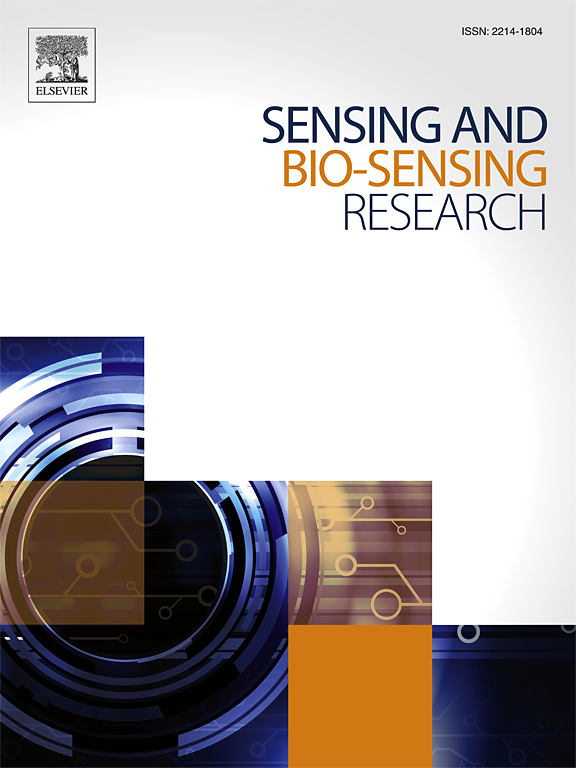Construction and optimization of a versatile bioFET platform for detecting nucleic acids and protein using the biotin–neutravidin affinity system
IF 5.4
Q1 CHEMISTRY, ANALYTICAL
引用次数: 0
Abstract
A biosensor based on a field-effect transistor (bioFET) is a promising system for point-of-care testing due to its portability and high sensitivity. A bioFET uses a linker platform to connect capture molecules to the FET, which detects electrical changes when targets bind to the capture molecules. This study presents the development and optimization of a versatile, highly sensitive bioFET platform utilizing a biotin–neutravidin affinity system capable of detecting both DNA and proteins. The bioFET was constructed using an extended-gate field-effect transistor (EGFET) with an aluminum gate functionalized with (3-aminopropyl)triethoxysilane (APTES)–biotin–neutravidin. We optimized the concentrations and molar ratio of biotin and neutravidin using fluorescence imaging and biosensing benchmarks. We found that 0.1 μg/mL biotin paired with 30 μg/mL neutravidin, approximately 1:1 in molarity, achieved optimal sensitivity. The optimized bioFET system demonstrated good sensitivity, with lower detection limits of 3.5 copies for Escherichia coli genomic DNA and 0.3 fg/mL for p-Tau217, an Alzheimer's disease biomarker. In summary, this study establishes the ideal conditions for constructing a bioFET system using an APTES–biotin–neutravidin linker capable of detecting DNA and proteins, with potential for convenient and sensitive point-of-care diagnostics.
利用生物素-中性生物素亲和系统检测核酸和蛋白质的多功能生物ofet平台的构建与优化
基于场效应晶体管(bioFET)的生物传感器由于其便携性和高灵敏度,是一种很有前途的即时检测系统。生物ofet使用一个连接平台将捕获分子连接到FET上,当目标与捕获分子结合时,FET可以检测到电变化。本研究提出了一种多功能、高灵敏度的生物ofet平台的开发和优化,该平台利用生物素-中性生物素亲和系统,能够检测DNA和蛋白质。该生物晶体管采用扩展栅极场效应晶体管(EGFET),铝栅极以(3-氨基丙基)三乙氧基硅烷(APTES) -生物素-中性生物素功能化。我们利用荧光成像和生物传感基准优化了生物素和中性花青素的浓度和摩尔比。我们发现0.1 μg/mL的生物素与30 μg/mL的中性生物素配对,摩尔浓度约为1:1,达到最佳灵敏度。优化后的bioFET系统具有良好的灵敏度,对大肠杆菌基因组DNA的检测限为3.5拷贝,对阿尔茨海默病生物标志物p-Tau217的检测限为0.3 fg/mL。总之,本研究为构建一个能够检测DNA和蛋白质的aptes -生物素-中性生物素连接体的生物ofet系统建立了理想条件,具有方便和敏感的即时诊断潜力。
本文章由计算机程序翻译,如有差异,请以英文原文为准。
求助全文
约1分钟内获得全文
求助全文
来源期刊

Sensing and Bio-Sensing Research
Engineering-Electrical and Electronic Engineering
CiteScore
10.70
自引率
3.80%
发文量
68
审稿时长
87 days
期刊介绍:
Sensing and Bio-Sensing Research is an open access journal dedicated to the research, design, development, and application of bio-sensing and sensing technologies. The editors will accept research papers, reviews, field trials, and validation studies that are of significant relevance. These submissions should describe new concepts, enhance understanding of the field, or offer insights into the practical application, manufacturing, and commercialization of bio-sensing and sensing technologies.
The journal covers a wide range of topics, including sensing principles and mechanisms, new materials development for transducers and recognition components, fabrication technology, and various types of sensors such as optical, electrochemical, mass-sensitive, gas, biosensors, and more. It also includes environmental, process control, and biomedical applications, signal processing, chemometrics, optoelectronic, mechanical, thermal, and magnetic sensors, as well as interface electronics. Additionally, it covers sensor systems and applications, µTAS (Micro Total Analysis Systems), development of solid-state devices for transducing physical signals, and analytical devices incorporating biological materials.
 求助内容:
求助内容: 应助结果提醒方式:
应助结果提醒方式:


